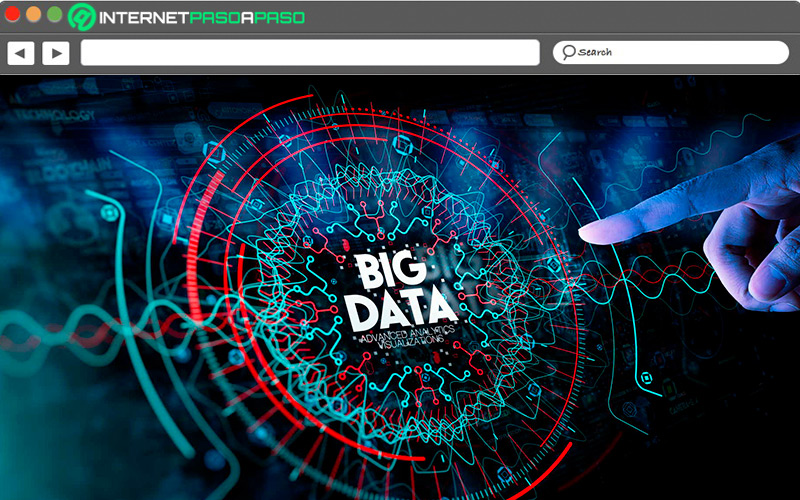
Index:
UPDATED ✅ Do you want to know more about big data technology and its impact on business? ⭐ ENTER HERE ⭐ and Learn Everything From Scratch ⭐
Nowadays there is a type of data processing that is revolutionizing the modern marketing industryIt is about Big Data. Its uses are multiple and even in opportunities they are estimated to be infinite, in fact what is known so far is a small part.
The reality is that any service or sector can take advantage of it and analyze mass behaviors. In addition, it is through it that companies are able to anticipate new trends and manage conditions in real time, even earlier.
Big Data is more than a list that groups data, it is partly the basis for other technologies to work perfectly. Pay attention to this material that will make you understand a little about what it is about, how it works and the challenges it faces.
What is the big data?

When talking about Big Data, it refers to a set of technologies designed with the intention to manage, collect and process data on the Internet. The objective or rather the intention is to collect raw and massive data from people, then process it and in parallel identify patterns or behaviors that help brands to sell more and better.
its complexity is due to the unstructured nature of a large amount of data generated by other technologies. It is important to note that the amount of data is exorbitant and even disproportionate, in other words invaluable.
History and Origin When was Big Data born?

The origin of Big Data does not have a clear date, because it was given progressively and has been developed along with the applications and merged with technology. The truth is that the first impulses were released in the late 1980s, specifically in 1989.
When Erik Larson coined the term “Big Data” and in parallel was birthing the world system World Wide Web, or in more popular terms “WWW”. From then on, a special interest was awakened and different companies were giving their contribution and the receptivity on the part of Big Data was favored in enormous proportions.
But the magic It happened precisely in the year 1997when Google launched its search engine. From there, between 2000 and 2005, companies emerged that generated and stored millions of data. The following years consolidated Big data, and gave rise to the birth of other advances such as web 2.0 and from there the growth was exponential. In this way, the labor market within multiple sectors changed its perspective.
How does Big Data work?
So that have a clearer idea of its definition, we will give you an example. When you browse the Internet, whatever the reason and how long it takes, you are generating data what is it contributing information.
From the moment you enter the browser, you start your search and you give signs of your interests, the pages that interest you or not. This is registered, not with your name, but in anonymity, in this way you enter the algorithms with a simple user that adds data to the data. Now this is done by millions of people every minute, so imagine all the data that is collected.
And that massive data is what is used in Big Data. Basically, the process is as follows:
- big data accept the data and store it.
- After, perform a data distribution on various processors.
- In this point data is processed and reassembled.
- By means of the data science techniqueprescriptive and predictive algorithms are used, and the required information is extracted.
Importance of big data

Does Big Data have any value? Of course yes. It is a fundamental part and the basis of communication and interactivity today. And it is not surprising that Big Data provides information and answers that in many cases companies had no idea existed. In other words, starting from a reference point you have unlimited access to be able to execute multiple strategies.
The power and importance of the big datahaving the ability to having so much information, shaping and testing is more than fabulous. When organizations are confident in their ability, they are able to identify more problems and even understand their origins.
Without a doubt, collecting large amounts of data opens the door to infinite answers. Consequently, this brings hundreds of advantages allowing brands to operate more effectively and efficiently. At the same time, these move faster and the best thing is that the use of data gives rise to new strategies and areas of opportunity.
There is a reality that cannot be hidden, the Big Data positively influences the internal movements of companies. In addition, they guide businesses towards smarter decisions, improve efficiency, increase productivity and/or employee performance, and increase profits. This without counting that at reduce customer service time, they will simply feel cared for and trusted.
The 3+2 Vs How is the size of a big data defined?

The Big Data requires instruments in order to fully perform its functions. entering the year 2001, an analyst named Gartner Doug Laney gave a more specific definition of big data, and in turn He explained that it was based on three factors: speed, variety and volume. Doug simplified his theory to what is known today as “the 3 Vs + 2 or 3+2 V”. And it refers to the following:
Volume
As we mentioned before, the volume is lost sight of. So you have an idea:
- A storage unit is based on terabyte which is equivalent to: 1,099,511,627,776 bytes
- One petabyte is equal to: 1,125,899,906,842,624
- The exabyte is equal to: 1,152,921,504,606,846,976
And this is what is known so far, because it grows indiscriminatelyand perhaps in a short time other terms will be defined. Every day the number of data is greater and the needs of the users will be of greater demand in the future, but this is not a problem for Big Data.
Speed
Big Data executes all its functions in real time, therefore the speed cannot be low, on the contrary it is extremely fast. Once the data arrives at the so-called “data lake”, it receives and expands every minute and feeds on data. When arriving, so much data, the response capacity is much greater. In other words, In the same way that information comes in, it comes out and more data is added to provide continuous analysis.
Variety
This factor belongs to the idea of 3 vs. Initially, it is about the input of data from multiple places, sources and formats. From anywhere and in various ways it is possible to provide more data, even with a simple fingerprint or facial recognition. Big Data has high potentialbecause it not only analyzes structured and unstructured data to improve the experience.
Veracity
What use can a date inaccurate? Well, it’s no use. Big Data, at the time of collecting the data, discards inaccurate or erroneous information. Making it clear that it focuses precisely on the right data, selecting only the safe and reduce risks to provide low-quality data.
Variability
It’s of vital importance talk about variable data, in other words, these are used for various scenarios. Much of the data is classified according to the functionality to whom it is needed and depending on the information, Big Data interprets it in the right way.
Big Data has the ability to be variable in order to contain all the information and collect information from any source. This is what makes it unique and positions it as one of the best alternatives today. In fact, it is in a way together with the other factors, it will be more relevant than ever.
Impact of big data on digital business

The impact of big data on digital business has been abysmal, and promises to be older with the passing of the years.
If we break down the advantages, it can be said that it interferes directly in the following aspects:
- Customer analytics are broader, and the data obtained improves the effectiveness of products and services. At the same time, it boosts the brand, increases sales and new acquisition rates.
- Finding the ideal client is not an easy task.. But, if you manage to collect the data and select and classify it, it is possible to reach the target audience without much effort.
- Another of the impacts of Big Data is that enables predictive analytics that chooses potential customers to be able to get directly to the sale of products or services.
- Among other things, it accommodates the contextual marketing because it integrates massive data in real time. On the other hand, it provides a personalized shopping experience through various channels and/or personal devices.
And the greatest impact is with respect to monetization, because they reduce many expenses and companies play it safe because they go directly to the real needs of consumers. In the same way, if applied, various concerns are slowed down and customer confidence is increasedwho, after all, are the ones who matter.
The Big Data offers organizations the possibilities to grow based on knowledge and reliable information. Its importance does not lie in storing massive data, but in knowing how to use it in favor of digital businesses.
Big Data quality challenges

The Big Data has always faced many challengesand it is that being one of the most important technological trends, it has had a direct impact in various sectors. However, at the moment the reality is a bit confusing, because there is still much to experience and know.
For this reason, several challenges have been identified that directly interfere with quality, these are:
talent shortage
a data scientist, He is a professional who, in addition to being a specialist in Big Data, earns a very high salary. But, in this case, the problem will not be money, since the answer is that many companies are willing to pay for these services. However, the problem is that the number of professionals in this area is scarce, because the best ones are already hired or are just in the process of being trained. Consequently, finding qualified staff is not that easy these days.
data quality
This is undoubtedly one of the biggest challenges of Big Data. The quality of the data that arrives must be precise, accurate and relevant. With so much scattered information, it is essential that the information is based on real data and this is what we want to achieve. Although currently, data with these characteristics arrive, this can be improved to almost perfection.
regulation
In the coming years it expects the company to have legal frameworks that are accepted or not before, during and after the data is processed and/or stored. This can be done globally, and from each company in particular. The idea is that everything remains completely legal and the rights and privacy of data and/or customers are not violated.
It is important to highlight that other areas should not be neglected. There are still many challenges for the big datawhere other no less considerable aspects interfere, such as cybersecurity. We must find a way to store the so-called “confidential”stay there in complete privacy and away from cyber attacks.
Similarly, the constant development of companies cannot be ruled out. just like Big Data has many benefits, it can become an obstacle. This occurs, above all, when it is not coordinated with the potential growth of the company and the technology that is implemented.
Computing